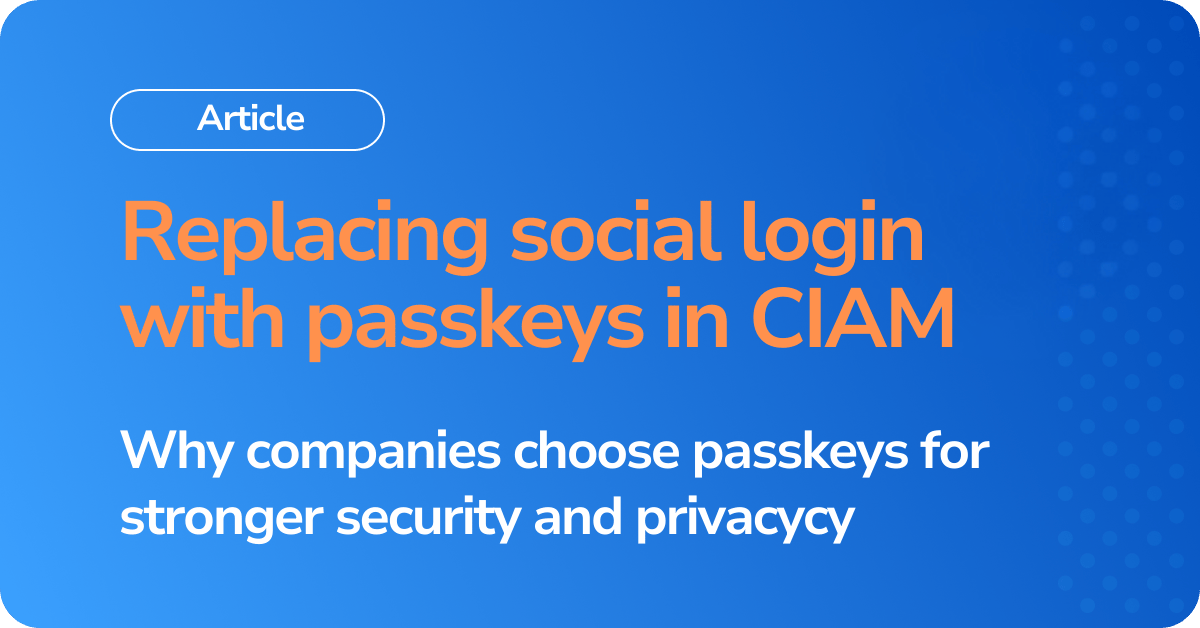Introduction: From Social Logins to Passkeys
For years, social login (Google, Facebook, LinkedIn) made it easy for users to sign up and log in. But this convenience comes with trade-offs: privacy risks, dependence on third-party providers, and security weaknesses.
Today, passkeys are emerging as the default alternative in Customer Identity and Access Management (CIAM). They provide stronger security, better privacy, and give companies full control over the user journey.
What Are Passkeys? (Quick Definition)
Passkeys are a form of passwordless authentication based on the WebAuthn standard.
- They use a public/private cryptographic key pair.
- The public key is stored by the company (Identity Provider).
- The private key is kept securely on the user’s device.
- Authentication happens through cryptographic signing, often combined with biometrics like Face ID or fingerprint.
👉 This makes passkeys phishing-resistant, fast, and user-friendly.

Why Social Login Is Losing Ground
1. Privacy Risks
- Social logins share user data with providers like Google and Facebook.
- Users often don’t realize how much personal information is exposed.
- This creates potential compliance issues with privacy laws (GDPR, CCPA, and others).
2. Lack of Business Control
- Companies depend on external APIs and policies.
- Changes in provider requirements (e.g., verification rules) can disrupt user access.
- The login flow is branded by the provider, not the business.
3. Security Concerns
- If a social account is hacked, all linked services are vulnerable.
- Password reuse and phishing remain risks.
- Businesses can’t fully manage or control the threat surface.
Why Companies Should Switch to Passkeys
1. Control and Customization
- Full ownership of authentication flows, branding, and data.
- Independence from third-party policies or disruptions.
- Greater flexibility in shaping the CIAM experience.
2. Enhanced Privacy
- Authentication events stay within the company’s environment.
- No external profiling or unnecessary data sharing.
- Easier compliance with global privacy regulations.
3. Stronger Security
- Passkeys are inherently phishing-resistant.
- Private keys never leave the user’s device.
- Multi-factor authentication is built into the passkey flow (device + biometric).
4. Better User Experience
- No passwords to remember or reset.
- Fast login with biometrics across iOS, Android, Windows, and macOS.
- Less friction during onboarding and authentication, leading to higher user retention.
How to Implement Passkeys in CIAM
- Many CIAM platforms (Okta, Auth0, Secfense, ForgeRock) already support passkeys.
- Start with hybrid login: offer passwords, social logins, and passkeys together.
- Gradually phase out third-party logins as users adopt passkeys.
- Provide onboarding education — tooltips, FAQs, and short tutorials — to ease user transition.
✅ Example: Companies introducing passkeys alongside existing options have been able to reduce dependency on social logins over time without disrupting the user experience.

FAQ: Passkeys vs. Social Login
Q: Are passkeys safer than social login?
Yes. Passkeys are phishing-resistant and don’t rely on third-party accounts.
Q: Do passkeys replace MFA?
Yes. Passkeys combine device-based security with biometrics, creating a strong form of multi-factor authentication by default.
Q: Can we still offer social login alongside passkeys?
Yes. Many companies keep both during transition, then retire social logins as adoption grows.
Conclusion: Future-Proofing CIAM with Passkeys
Replacing social login with passkeys gives organizations:
- Control over authentication flows and data
- Privacy by eliminating third-party exposure
- Security through phishing-resistant MFA
- Seamless UX across devices and platforms
As users demand stronger privacy and regulators raise security expectations, passkeys are becoming the new standard for CIAM. Companies that adopt them early will gain trust, reduce risk, and future-proof their identity strategy.
Conclusion: Future-Proofing CIAM with Passkeys
Replacing social login with passkeys gives organizations:
- Control over authentication flows and data
- Privacy by eliminating third-party exposure
- Security through phishing-resistant MFA
- Seamless UX across devices and platforms
As users demand stronger privacy and regulators raise security expectations, passkeys are becoming the new standard for CIAM. Companies that adopt them early will gain trust, reduce risk, and future-proof their identity strategy.
👉 At Secfense, we help enterprises adopt passkeys without rewriting applications or disrupting existing systems. Our no-code approach makes it possible to deploy phishing-resistant MFA across all apps — including legacy ones — in days, not months.
If you’re ready to explore how passkeys can strengthen your CIAM strategy, book a demo with Secfense and see how easily you can modernize authentication.
